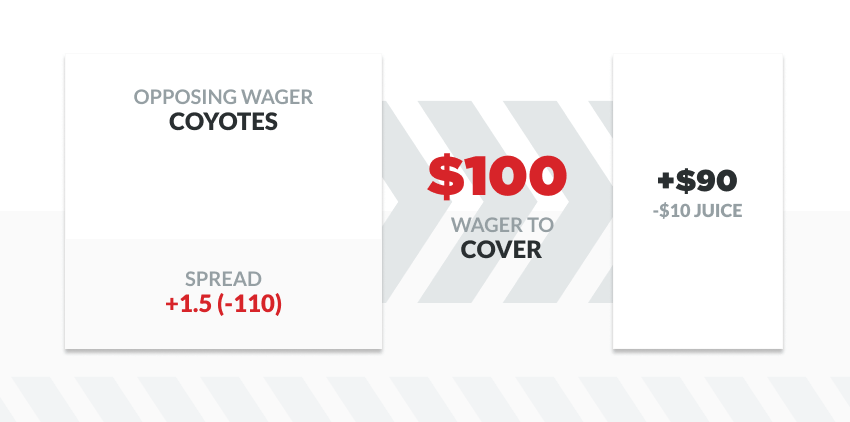How To Hedge Your Sports Bets
- How To Hedge Your Sports Bets
- How To Hedge Your Sports Bets Without
- Hedging Your Bet
- Hedge Bet Calculator
You must decide either to let the bet ride in the belief he will go on to win or hedge your bets and lock in a guaranteed profit if you believe he is less likely to win. To hedge your bet, you can either use the.
- While hedging bet can seem like a challenging strategy to master, the concept is simple. Hedging involves placing a new bet on a different outcome than the one you originally wagered on.
- This would be a clear case of “hedging our bets”. There are countless other examples of how people hedge their bets in various aspects of their life. This article is all about how hedging works in sports betting though. We believe that the hedging.
- The original bet wins: The Lions win the Super Bowl, and your profit on your futures bet is $6,000 over and above your initial stake of $100. Your hedge bet is a loss, so you lose the stake of $1,000. Your total profit is $5,000. The hedge bet wins: The Jets win the Super Bowl, and your profit is $2,000 over and above your initial stake of $1,000. Your futures bet.
What is Hedging?
Hedging bets are essentially bets on the opposite side of your original bet to reduce the risk of your initial bet. Arbitrage betting is essentially an extreme form of this, where the odds are so different that your hedge guarantees profit regardless of the outcome.
How Can I Calculate a Hedge Bet?
The formula for calculating a hedge bet that splits the possible profit between both scenarios is actually quite simple:
HB = (P1 + B1) / O1
where:
HB = Hedge bet amount
P1 = Profit from original bet
B1 = Original bet amount
O1 = Hedge bet decimal odds
You can then determine the profit you would make regardless of outcome using the following formula:
P = (HB – P1)
where:
P = Profit regardless of outcome
HB = Hedge bet that was just calculated
P1 = Profit from original bet from previous equation
Tip: Based on the hedge bet equation, you should odds shop while hedging. Go to an odds aggregator like Oddschecker and pick the highest decimal odds possible on the team for your hedge bet. The higher the odds, the more profit you will be able to extract from hedging bets.
Why and When Would I Hedge a Bet?
There are certain circumstances where hedging bets would be very beneficial.
This can either be to lock in profits or to minimize losses on an existing bet.

Futures Bets
Let’s say that you placed a $100 bet for the Pittsburgh Steelers to win the super bowl at the beginning of the season at +10000 odds.
They just won the AFC championship and are headed to the super bowl to play the Seattle Seahawks. Clearly, the payoff for you, if the Steelers win the super bowl, is quite large. Although, if they lose, you don’t want to lose all of your winnings. You can hedge this bet by betting on the Seahawks to win the super bowl at their current pregame odds of +200 (3.0 decimal odds). Now in either scenario, you will make money.
Hedge Bet on Seahawks = ( $10,000 + $100) / (3.0) = $3,367
Profit Regardless of Outcome = ($10,000 – $3,367) = $6,633
Hedging Parlays
In the scenario where you are on the last leg of your parlay bet, it is a smart idea to place a hedging bet on the last leg of your parlay.
Since you don’t want to lose all of your parlay gains if the last leg fails, it is wise to hedge against the outcome you bet on in the last leg of your parlay.
Hedging to Minimize Losses
Let’s say you bet on a team to win a match. Then their star player gets hurt before the match and is not able to play anymore. This greatly diminishes the team’s ability to win.
You can minimize the losses you would expect by placing a hedge bet against your original team. In this case, you will likely be guaranteed to lose money, but the losses are much lower than you would have incurred had you not placed the hedge bet and the opposite team wins.
Cancel a Bet Made on Accident

Accidently placed a bet?
Sportsbooks don’t really offer the ability to cancel bets, or everyone would cancel bets if the match started to go in the opposite direction.
By placing a hedge bet against the bet you placed on accident, you will likely just incur a small loss instead of losing more money if the accidental bet lost.
Hedging In-Play
You place a bet on the Steelers to win vs. the Seahawks pregame, and they are crushing it, but they are playing a team that could come back.
By placing a live hedge bet on the Seahawks during the game, you can protect yourself from incurring losses if they come back and win.
Conclusion
Hedging may not always be worth it. Sometimes you place a small bet just for fun. Is it really worth taking the time to hedge this small bet? Probably not. Although, by using hedging in some of the scenarios above, you can lock in profits. Over time this can make the difference between successful and unsuccessful sports bettors.
If you’re interested in a way to make easy, low-risk profits in a strategy similar to hedging, we recommend you check out our Guide to Arbitrage Betting. Arbitrage betting is one of the only ways bettors can actually make money sports betting in the long run.
Already know what arbitrage betting is? Live in the U.S? Feel free to check out our service! Surefire Betting is the only U.S.-focused sports betting arbitrage database.
In sports betting, hedging a bet means betting both sides of a game to safe guard against a loss.
Let’s say at the start of the American football season you put $1,000 on an 8 to 1 shot winning the Super Bowl. They eventually make the Super Bowl as the favorites. The night of the game their opponent is 2 to 1. If you now bet $3,000 on their opponent (this being the hedge bet) you are guaranteed $5,000 profit no matter which team wins.
Another example is having 5% of your bankroll on a 1 to 5 favorite. The game doesn’t start well, and you end up using in-play betting to lock in a 1% loss. In this case by hedging you surrendered 1% of your bankroll to safe guard the 4% that was previously at risk.

The above scenarios are reasonable for even professional bettors to find themselves in. In this article I provide the math for calculating hedge stakes, and also discuss when it is strategically correct to do so. First, I cover another frequent hedging scenario that is almost exclusive to novice bettors. As this is a very common mistake I go into detail explaining it.
Hedging Parlay Bets
As a moderator of one betting forum, and a long time regular posters on others, I often see posts that are along the lines of:
“I bet $100 on a 6 team parlay (accumulator) that pays 45/1. The first five teams have won and the other is playing tonight. Should I bet their opponent at -110 to lock in a guaranteed win? If so for how much?”
It is very common for recreational bettors to add an additional team to their parlays with the intention of hedging it back should it get that far. If you are someone who does this, please read closely.
Understand that a parlay bet is nothing more than rolling a stake plus win forward again and again. Let’s look how it works on $100 using 6 bets with American odds -110.
– Bet1: $100 to win $90.91 – if win you have $190.91
– Bet2: $190.91 to win $173.55– if win you have $364.46
– Bet3: $364.46 to win $331.33 – if win you have $695.79
– Bet4: $695.79 to win $632.54 –if win you have $1,328.33
– Bet5: $1,328.33 to win $1,207.57 –if win you have $2,535.91
– Bet6: $2,535.91 to win $2,305.37 – if win you have $4,841.27
If you win all 6 you have 48.41 times you stake. As 1 was your stake this means the payout is 47.41 to 1 which in American odds is +4741. At Bovada, 5Dimes, and Bookmaker this is exactly what a 6 teamer pays when all point spreads are -110. However, there are other sites that essentially cheat players by using fixed odds. Examples include BetOnline who pays 45/1 and Topbet 40/1 on 6-teamers. This is legit as each has these payouts built it into their rules, but it is this way only to take advantage of novice bettors that don’t know any better. www.bovada.lv is a much better choice.
So, the first mistake was likely getting +4500 when +4741 was available. But, even if you had the full pay ($100 to win $4,741.27), let’s look what happens when you hedge. In order to lock it in so the profit is the same no matter which team wins you’ll now need to stake $2,535.90 on their opponent winning at American odds -110.
This gives two bets. These are:
– Bet 1 = $100 to win $4741.27
– Bet 2 = $ 2,535.90 to win $2,305.36
If Bet 1 wins, on the winning bet you get +$4741.27 and -$2535.90 on the losing one = +$2,205.37
If Bet 2 wins you get +$2305.36 on the winning one and -$100 on the losing one = +$2,205.36
Aside from the penny that can’t be split, you’ve now hedged in such a way the profit is the same regardless of which team wins. Now here’s the kicker. Go back up to where I showed manually rolling forward stake plus win and note: ”Bet5: $1,328.33 to win $1,207.57 –if win you have $2,535.91”. Do you see what a huge mistake adding extra teams to parlays only to hedge is?
If you had bet a 5-team parlay $100 turns to $2,535.91 when all 5 win. By adding a sixth team and then hedging it back, instead those same five teams winning gives you a return of only $2,205.36. That is $330.55 thrown away for no reasons at all.
Please note that even when dealing with moneyline parlays where each has different odds the result is the same. It doesn’t matter the order or anything else. The parlay payout is the same as rolling over stake plus win on each bet, no matter what odds you select.
If you’re in this scenario now, then perhaps you should hedge. This is covered in the next section. Just hopefully this section has resulted in lesson learned and you will avoid getting into the same situation in the future.
When Does Hedging Make Sense
Anytime the stakes involved are significant a hedge is ideal. There is a lot of poor advice on forums that explain otherwise by stressing the importance of expected value. This is where understanding Kelly Criterion helps. In that article, in laymen terms I explain the importance of maximizing expected growth (EG) over expected value (EV). This is also how advanced bettors should determine their hedge stakes. That aside, here are some general bullet points.
When to Hedge:
1) When the second wager is also +EV
This can happen for a variety of reasons. Perhaps you found an arbitrage situation and are betting both simultaneously. Perhaps, you’re watching television and see a player is injured and can act in those few seconds before the in-play betting odds adjust.
2) When hedging was a consideration before you placed your original bet
There are countless reasons to make over-bets. Perhaps you see a line of -6.5 in a football match and strongly suspect it will move to -7, but probably won’t move to -6. Here you might over-bet with the plan to buy it back later for a profit or for a +EV middle attempt. There are many other scenarios with future bets, live trading on betting exchanges, etc. where hedging was a known option at the time the original bet was placed.
3) Anytime you’re overexposed
Again, this can be from foolishly adding additional teams to parlays. It might also be because an outside circumstance required you to reduce your bankroll while bets were pending. It could also be that an arbitrage or over-bet situation that went bad.
As you can see hedging is not the cardinal sin that it is often made out to be. The times you should avoid hedging is when the stakes are within your normal bet sizing (unless with no regard to your initial bet, on its own, the other side becomes +EV). The bad reputation hedging gets is somewhat deserved, because people put themselves into hedge scenarios for the wrong reason. Betting a team to win Super Bowl instead of conference, or division. Blindly over betting large favorites and cutting losses, adding more teams to parlays etc. If you avoid these and do it right, again, it does often make sense to hedge your bets.
How to Calculate a Hedge Stakes?
This is all simple algebra. Let’s say you have $100 staked on +800. The $100 is sunk, it is already in the pot so to speak. If the bet wins you get back that $100 stake, and you get the $800 winnings too, for a $900 return. Calculating hedge stakes is always based on the return. Let’s now say the other side is -465. The question is: how much do we need to bet on -465 for stake plus win to equal the same $900 return?
Most sports bettors are aware (and if you’re not please read: How Sports Betting Works) that when American odds are negative you can calculate the payout on any stake by dropping the negative sign, moving decimal over 2 places, and then dividing it by stake. For example $100 staked on -465 is $100/4.65=$21.51. Therefore $100 on bet -465 is risk $100 to win $21.51. Okay so our hedge stake equation is going to include the 4.65 for the -465 and is going to include the $900 return. Ordering this is pretty simple. That equation is:
STAKE+(STAKE/4.65)=$900
The math to solve that is simple, but if you’re presently void of grade 6 algebra skills, use an algebra.com calculator to solve that. Call stake A and format the equation as A+A/4.65=900. Using that algebra.com link, you’ll see A (stake)= $740.71. This gives us two bets.

– Bet 1 = $100 to win $800 (that’s a $900 return).
– Bet 2 = $740.71 to win 159.29 (that’s also a $900 return).
No matter which side wins we get $900 back. All together we’ve staked $100 on bet 1 + $740.71 on bet 2 for a total of $840.71. So no matter which team wins we now profit $900-$840.71=$59.29. We’ve hedged our bet in full.
Hedging 3 Way Lines
Hedging wagers with 3 or more options to bet is no different. Let’s say for a soccer match the odds are:
Home: +129
Draw: +258
Away: +229
We bet $2,000 on +129 as we calculated a huge edge. Then we find out we made a mistake. There are star players out, and now is breaking news other players are going to rest too. We decide we want off this position in a hurry. How do we hedge? Well our first bet was $2,000 to win $2,580. The return is therefore $4,580. To hedge we need to bet the amount that has stake plus win total $4,580 on each of the other options.
How To Hedge Your Sports Bets
In this case where dealing with positive American odds so payouts calculate as stake+(stake*odds)=payout. Note: odds are the American odds with decimal moved over 2 places.
On +258 our equation is:
A+(A*2.58)=4580
Which solves to A (stake) = 1279.33
How To Hedge Your Sports Bets Without
On +229 our equation is:
A+(A*2.29)=4580
Which solves to A (stake) = 1392.10
We now have 3 bets.
– Bet 1 = Risk $2,000 to win $2,580 (that’s a return of $4,580)
– Bet 2 = Risk $1,279.33 to win 3300.67 (that’s also a return of $4,580)
– Bet 3 = Risk $1,392.10 to win 3187.91 (that’s a return of $4,580.01)
Add the risks amounts of each (2,000+1,279.33+1392.10) and see we have 4671.43 at risk. We get back $4,580 no matter which team wins. As $4,580-4671.43=-91.43 we can see we’ve now hedged off the $2,000 we once had at risk, and are taking a $91.43 loss no matter if home wins, away wins, or it is a draw.
Hedging Your Bet
There are many calculators that can be found searching Google that will do the math for you in calculating a hedge stake. For more advanced users you can find spread sheets for using Excel solver. As this article is in our beginners section, the purpose here was to just give a solid introduction to sports betting hedge bets.
Hedge Bet Calculator
Author: Jim Griffin